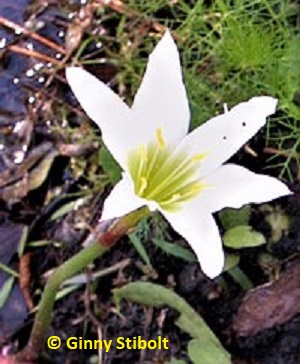Adventures of a Transplanted Gardener |
|||||||
Rain lilies for my rain gardens
| |||||||
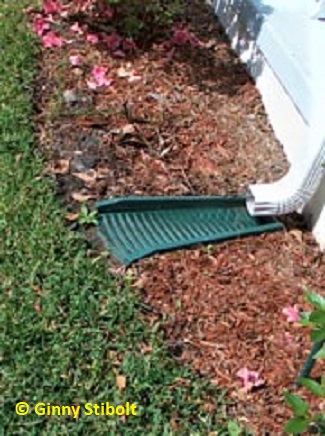 Downspout before the |
I started with the easiest project where a downspout emptied directly into the lawn. Not much erosion here, but the lawn was really soggy after every downpour and the plastic deflector was tipped toward the house creating mosquito-attracting puddles after each rain. But this rain garden was mostly for aesthetics. I removed about 18 inches of lawn, reset the runoff tray, and set in some river stones over a bed of gravel. This location receives lots of sun, so I planted two sun-tolerant ferns: ebony spleenwort (sic)(Asplenium platyneuron) and netted chainfern (Woodwardia areolata). I also planted rain lilies (Zephyranthus atamasco) alongside the rocks. I added some moss between the rocks to soften their appearance and make the installation look less new.
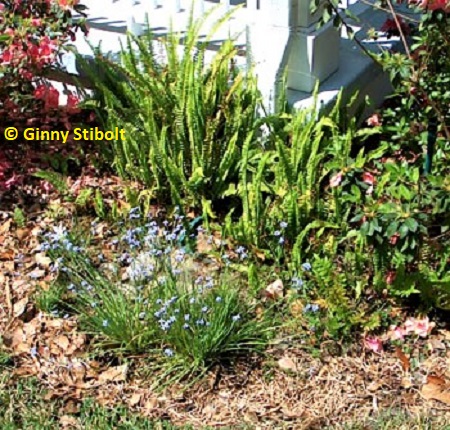 A year later, the downspout rain garden provides interest and slows down the outflows. |
Note for non-Florida readers: If your house has a basement, locating a rain garden this close to the foundation would not be prudent. You would use a French drain to take water away from your foundation and install your rain garden so the draining water will not end up in your basement.
The ferns grow in great mats in the woods along the drainage gully from our pond to the lake. I found the rain iilies in a drainage ditch not far from my house. When removing plants from an existing population, take them from the middle overcrowded areas, then replace the divot like a golfer. Leave the edges of the population alone so that it may expand naturally. Do not remove these threatened plants from roadside ditches or other public property.
(Update: those upright ferns are not spleenworts but the invasive tuberous swordfern (Nephrolepis cordifolia). I've removed them from this rain garden and continue to knock them back in the wooded area.)
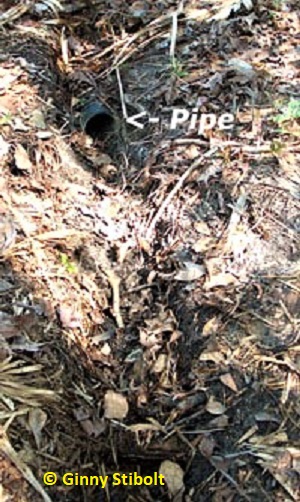
Erosion from gutteroutflow before the rain garden. |
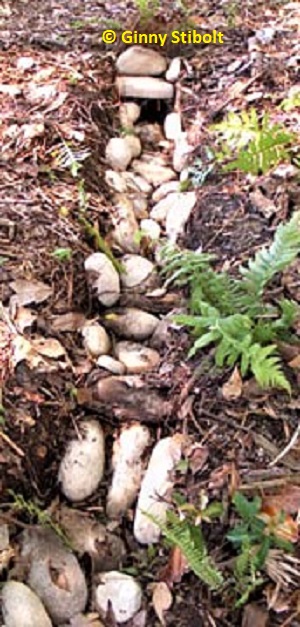
Rocks help prevent erosion. |
The two outflows from French drains located at the top of the drainage gully from the pond to the lake had caused significant erosion. The first step was to fill in the hole under each pipe and then create a smooth path for the water from the pipes to the stream using the rocks. The idea here was not so much to slow the water, as to keep it from further eroding the bank until it reached the bottom of the slope. At the bottom I created a wider area where water can pool before it flows into the drainage ditch.
Because of the shade and because these areas are hidden away, I didn't plant Rain Lilies. In addition to the Spleenworts and Netted Chain Ferns, I also planted cinnamon ferns (Osmunda cinnamomea) and Virginia chain ferns (Woodwardia virginica). These two large ferns look almost alike except for the cinnamon stick fertile fronds of the cinnamon ferns that are evident in the spring. Of course, here in Florida, I noticed that they are produced in the fall, too. Double your pleasure.
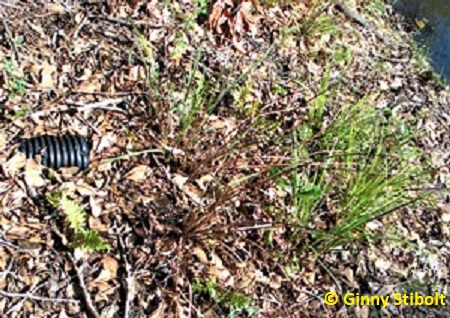 The French drain pipe next to the pond. |
The last rain garden is out by the pond at the outflow from the French drain system in the front of the house. This one needed the least amount of work because Cinnamon Ferns, grasses, and a small holly were a lready growing in front of the pipe.
I put rocks around the pipe and between the existing plants. Then toward the bottom of the garden I created a pooling area where I planted more Cinnamon Ferns and several bunches of unidentified rushes.
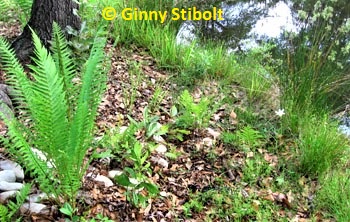
Rocks arranged around the plants create a great bioswale to
absorb water in this spot. |
A rush looks like a coarse, spiky kind of grass. The stems are round, but the flowers don't form at the top of a stem like a grass. They sprout from side of the stem near the top. I found quite a few rushes growing in low areas of the lawn. Since we didn't mow all winter, they were conspicuous amongst the grasses with their upright, darker green stems. Rushes love soggy or boggy areas, so I dug them out of the lawn. The ones I didn't use for the rain gardens were planted along the edge of the pond.
The runoff from our cement driveway did not require a rain garden because it is directed into a forested area where Cinnamon Ferns, Red Maples (Acer rubrum), Sweet Gums (Liquidambar styraciflua) and Southern Bayberries (Morella cerifera) tolerate and absorb the standing water. Runoff from driveways and roads contain oil and other fluids that leak from vehicles, so it's important that this runoff not go directly into our waterways. Let it percolate through the soil so by the time it reaches the aquifer, it's cleaner.
Rainwater is not a waste product, but a valuable resource.
Rain gardens and rain barrels, which I talked about last time, are two simple ways that everyone can help to save water and reduce the impact of storm water runoff on our waterways.
Resources:
- See the progress of a rain garden in Expanded Rain Garden.
- Learn how to create a large dry well or a water sink to expand the capcity of a rain garden in A New Bed... and Standing Stormwater
- More resources are on the EPA's webpage: Polluted Runoff: Nonpoint Source (NPS) Pollution.
Ginny Stibolt is a life-long gardener, a botanist, a naturalist, and a garden writer. You may contact her or read more of her articles posted on her website: www.greengardeningmatters.com.
Copyright Ginny Stibolt


